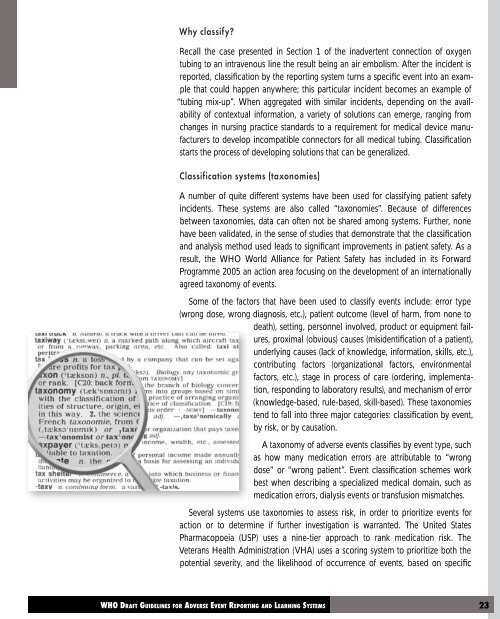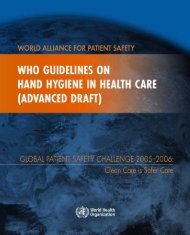Adverse event reporting.pdf
Adverse event reporting.pdf
Adverse event reporting.pdf
Create successful ePaper yourself
Turn your PDF publications into a flip-book with our unique Google optimized e-Paper software.
Why classify?<br />
Recall the case presented in Section 1 of the inadvertent connection of oxygen<br />
tubing to an intravenous line the result being an air embolism. After the incident is<br />
reported, classification by the <strong>reporting</strong> system turns a specific <strong>event</strong> into an example<br />
that could happen anywhere; this particular incident becomes an example of<br />
“tubing mix-up”. When aggregated with similar incidents, depending on the availability<br />
of contextual information, a variety of solutions can emerge, ranging from<br />
changes in nursing practice standards to a requirement for medical device manufacturers<br />
to develop incompatible connectors for all medical tubing. Classification<br />
starts the process of developing solutions that can be generalized.<br />
Classification systems (taxonomies)<br />
A number of quite different systems have been used for classifying patient safety<br />
incidents. These systems are also called “taxonomies”. Because of differences<br />
between taxonomies, data can often not be shared among systems. Further, none<br />
have been validated, in the sense of studies that demonstrate that the classification<br />
and analysis method used leads to significant improvements in patient safety. As a<br />
result, the WHO World Alliance for Patient Safety has included in its Forward<br />
Programme 2005 an action area focusing on the development of an internationally<br />
agreed taxonomy of <strong>event</strong>s.<br />
Some of the factors that have been used to classify <strong>event</strong>s include: error type<br />
(wrong dose, wrong diagnosis, etc.), patient outcome (level of harm, from none to<br />
death), setting, personnel involved, product or equipment failures,<br />
proximal (obvious) causes (misidentification of a patient),<br />
underlying causes (lack of knowledge, information, skills, etc.),<br />
contributing factors (organizational factors, environmental<br />
factors, etc.), stage in process of care (ordering, implementation,<br />
responding to laboratory results), and mechanism of error<br />
(knowledge-based, rule-based, skill-based). These taxonomies<br />
tend to fall into three major categories: classification by <strong>event</strong>,<br />
by risk, or by causation.<br />
A taxonomy of adverse <strong>event</strong>s classifies by <strong>event</strong> type, such<br />
as how many medication errors are attributable to “wrong<br />
dose” or “wrong patient”. Event classification schemes work<br />
best when describing a specialized medical domain, such as<br />
medication errors, dialysis <strong>event</strong>s or transfusion mismatches.<br />
Several systems use taxonomies to assess risk, in order to prioritize <strong>event</strong>s for<br />
action or to determine if further investigation is warranted. The United States<br />
Pharmacopoeia (USP) uses a nine-tier approach to rank medication risk. The<br />
Veterans Health Administration (VHA) uses a scoring system to prioritize both the<br />
potential severity, and the likelihood of occurrence of <strong>event</strong>s, based on specific
















